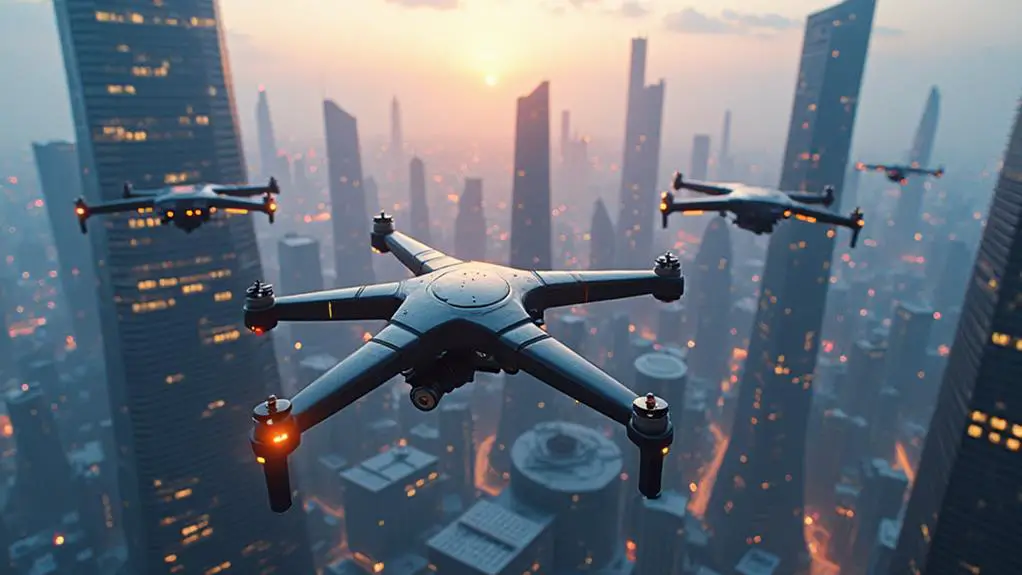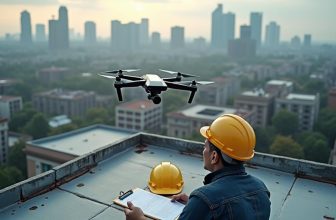
You're likely no stranger to drones, but recent breakthroughs in the technology might surprise you. Advances in propulsion systems, autonomous navigation, and solar power have significantly improved drone capabilities. You're probably wondering what these developments mean for industries like surveillance, delivery, and search and rescue. With electric motors reducing noise pollution and AI-driven navigation enhancing safety, the possibilities seem endless. But what exactly are these three breakthroughs, and how will they change the way drones are used? The answer lies in a closer look at the innovations driving this tech forward.
Contents
- 1 Key Takeaways
- 2 Advanced Propulsion Systems
- 3 AI-Driven Autonomous Navigation
- 4 Solar-Powered Endurance Flight
- 5 Frequently Asked Questions
- 5.1 How Do Drones Maintain Communication With Ground Control Systems?
- 5.2 What Safety Features Prevent Drone Collisions With Other Aircraft?
- 5.3 Can Drones Be Used for Search and Rescue Operations at Night?
- 5.4 How Do Weather Conditions Affect Drone Flight Performance and Safety?
- 5.5 Are Drones Allowed to Fly Over Private Property and Public Events?
- 6 Conclusion
Key Takeaways
- Advanced electric motors offer higher power-to-weight ratios, enabling improved thrust efficiency and longer flight times.
- AI-driven autonomous navigation systems use real-time data and machine learning algorithms for precise obstacle avoidance and tracking.
- Solar-powered drones can fly for hours or days using energy harvested from solar panels, making them ideal for long-range missions.
- Turbofans have gained traction in the drone industry, enabling efficient high-speed flight and heavier payload capacity.
- Efficient propulsion systems are crucial for unlocking the full potential of drone technology and enabling faster, more efficient flight.
Advanced Propulsion Systems
The marriage of electric motors and advanced battery technology has given birth to more efficient propulsion systems in drones.
You're witnessing this evolution firsthand, as drone manufacturers increasingly adopt electric motors for their designs. These electric motors offer a higher power-to-weight ratio, resulting in improved thrust efficiency and longer flight times.
Additionally, they're quieter and produce less vibration, making them ideal for applications requiring stealth or reduced noise pollution.
Turbofans, a type of turbine-based propulsion system, have also gained traction in the drone industry.
They work by using a turbine to drive a fan, which generates a significant portion of the thrust. This design allows for more efficient high-speed flight, making it suitable for larger drones or those requiring faster speeds.
As you explore the realm of advanced propulsion systems, you'll notice that both electric motors and turbofans are being fine-tuned for optimal performance.
By optimizing these systems, manufacturers can create drones that are faster, more efficient, and capable of carrying heavier payloads.
Efficient propulsion systems are crucial for unlocking the full potential of drone technology.
Sophisticated navigation systems in drones now rely heavily on AI-driven autonomous navigation, where complex algorithms and real-time data processing enable drones to adapt and respond to dynamic environments.
As you navigate your drone through complex environments, AI-driven autonomous navigation systems continuously collect and process data from various sensors, such as GPS, accelerometers, and cameras.
This real-time data processing allows for precise real-time tracking of the drone's position, velocity, and orientation.
Advanced obstacle avoidance systems are also enabled by AI-driven autonomous navigation.
These systems use machine learning algorithms to detect and classify obstacles, such as trees, buildings, or power lines, and adjust the drone's flight path accordingly.
This enables drones to safely navigate through dense environments and avoid potential hazards.
By combining real-time tracking and obstacle avoidance capabilities, AI-driven autonomous navigation systems have significantly improved the safety and efficiency of drone operations.
As you experience the benefits of AI-driven autonomous navigation, you'll appreciate the increased reliability and precision of your drone's navigation system.
With these advancements, you can focus on achieving your mission objectives with confidence.
Solar-Powered Endurance Flight
Flying for extended periods has long been a limitation of traditional drones, but solar-powered endurance flight technology is now pushing those boundaries.
You can now expect to see drones flying for hours, even days, on end, thanks to advancements in energy harvesting.
This is made possible by integrating solar panels into the design of the drone, typically on the wings or body, to capture and convert sunlight into electrical energy.
This energy is then stored in onboard batteries, allowing the drone to continue flying even when the sun is no longer shining.
- Increased Flight Time: Solar-powered drones can fly for hours longer than traditional drones, making them ideal for long-range missions.
- Reduced Weight: By harnessing energy from the sun, drones can carry less battery weight, increasing efficiency and agility.
- Lower Operating Costs: With reduced battery replacement and recharging needs, solar-powered drones can save you money in the long run.
- Environmental Benefits: Solar-powered drones produce zero emissions, making them a more environmentally friendly option for aerial operations.
Frequently Asked Questions
How Do Drones Maintain Communication With Ground Control Systems?
When you operate a drone, it maintains communication with ground control systems through radio frequencies, using techniques like Frequency Hopping to minimize interference, while employing Data Encryption to secure transmitted data and prevent unauthorized access.
What Safety Features Prevent Drone Collisions With Other Aircraft?
You might think drone collisions are inevitable, but they're not. You'll find airborne sensors and collision avoidance systems on most drones, which actively detect and respond to nearby aircraft, significantly reducing the risk of a mid-air crash.
Can Drones Be Used for Search and Rescue Operations at Night?
You can utilize drones for nighttime search and rescue operations with advanced night vision and thermal imaging capabilities, enabling you to detect heat signatures and visualize targets in low-light environments, increasing the effectiveness of your missions.
How Do Weather Conditions Affect Drone Flight Performance and Safety?
You might think weather doesn't impact drone flight, but think again. In foggy landscapes, visibility is reduced, and turbulent winds can destabilize your drone, requiring adjustments to speed, altitude, and navigation to ensure safe and stable flight.
Are Drones Allowed to Fly Over Private Property and Public Events?
When flying drones, you must consider privacy concerns and airspace rights. You generally need permission to fly over private property, but public event rules vary, often requiring permits or following specific airspace regulations and restrictions.
Conclusion
As you gaze up at the sky, you'll notice drones no longer just hover – they soar. The latest breakthroughs have transformed them into birds of innovation, their electric motors and turbofans the wings that lift them to new heights. AI-driven navigation is the compass that guides them, while solar power is the boundless sky that fuels their flight. Together, they form a symphony of progress, signaling a future where technology and sustainability take flight.






